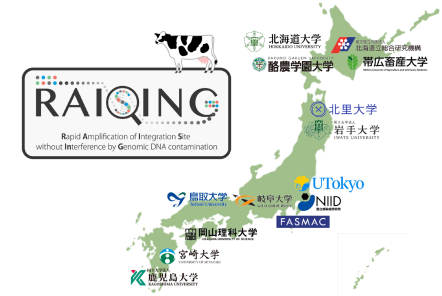2025-03-28 北海道大学,国立感染症研究所,株式会社ファスマック,北海道立総合研究機構,酪農学園大学,帯広畜産大学,岩手大学,北里大学,東京大学,岐阜大学,鳥取大学,岡山理科大学,宮崎大学,鹿児島大学,伊藤記念財団

国内の 14 研究機関における多施設検証試験
<関連情報>
- https://www.hokudai.ac.jp/news/2025/03/raising14.html
- https://www.hokudai.ac.jp/news/pdf/250328_pr.pdf
- https://www.jstage.jst.go.jp/article/jvms/advpub/0/advpub_25-0031/_article
牛伝染性リンパ腫ウイルス感染細胞のクローナリティ解析のための改良型RAISING法の性能評価―日本における多施設共同研究 Performance evaluation of an improved RAISING method for clonality analysis of bovine leukemia virus-infected cells: a collaborative study in Japan
Tomohiro OKAGAWA, Naomi NOJIRI, Hazuka YOSHIDA-FURIHATA, Naganori NAO, Misono TOMINAGA, Junko KOHARA, Satoshi GONDAIRA, Hidetoshi HIGUCHI, Yohei TAKEDA, Haruko OGAWA, Shinji YAMADA, Kenji MURAKAMI, Yasunori SUZUKI, Shinji TAKAI, Masaki MAEZAWA, Hisashi INOKUMA, Kaori SHIMIZU, Yasuo INOSHIMA, Tatsufumi USUI, Michihito TAGAWA, Mari YAMAMOTO, Hirohisa MEKATA, Mana ESAKI, Makoto OZAWA, Takahiro MATSUDAIRA, Naoya MAEKAWA, Shiro MURATA, Kazuhiko OHASHI, Masumichi SAITO, Satoru KONNAI
Journal of Veterinary Medical Science Advance online publication: March 28, 2025
DOI:https://doi.org/10.1292/jvms.25-0031
Abstract
Bovine leukemia virus (BLV), a retrovirus that is widespread worldwide, causes enzootic bovine leukosis (EBL), a B-cell leukemia/lymphoma with a poor prognosis that ultimately results in death. In Japan, the number of cattle infected with this virus is increasing, and it is estimated more than 35% of cattle are currently infected. Since no vaccines or treatments against BLV infection are currently available, it is important to establish a method of early diagnosis for EBL to reduce economic losses caused by the disposal of EBL cattle in Japan, where a large number of expensive beef cattle are raised. We previously developed Rapid Amplification of the Integration Site without Interference by Genomic DNA Contamination (RAISING), a cost-effective, rapid, and sensitive method for the clonality analysis of BLV-infected cells. Despite its usefulness for the early diagnosis of EBL, RAISING had drawbacks preventing its practical application. Here, we report the development of an improved method, RAISING ver.2, and its performance. Compared to BLV clonality analysis using the previous method, RAISING ver.2 was found to maintain high accuracy and reproducibility despite its simplification. Moreover, its performance was also validated in a multicenter validation study. Taken together, our results strongly suggest that RAISING ver.2 can be fully utilized in clinical practice. Successful commercialization of a RAISING test kit could overcome the concerns of livestock farmers suffering from EBL, thereby promoting a stable supply of Japanese beef, both domestically and internationally.



